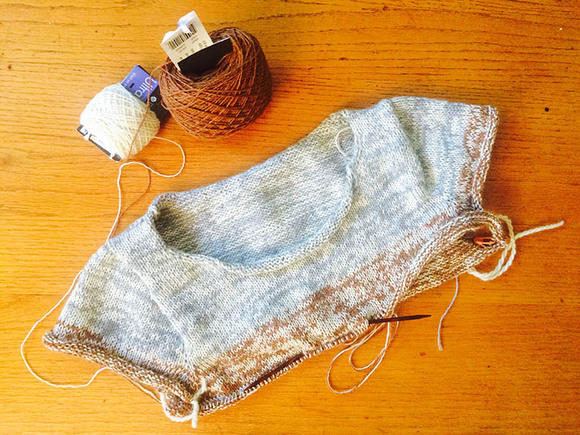Meet The Arno Pullover from Speckle & Stone
At first glance my Arno Pullover may look rather ordinary, but it is actually a very special design that truly deserves a closer look.

What makes this sweater so special is it's innovative construction. The set-in style sleeve cap and shoulder are worked simultaneously, seamlessly, and from the top-down. In other words, absolutely no sewing or grafting is required!! It's practically fail-proof and comes out beautifully every time.
I always loved the look of a set-in sleeve cap, so I challenged myself to devise a new way to knit this style that requires no sewing whatsoever. The math was a bit of a marvel, but I eventually figured it out and used the construction for the first time for the Rook Pullover in my book Graphic Knits (which I blogged about here).
To help you wrap your head around this unique construction, I drew a little illustration to show how the modular pieces all come together:

1. The back shoulder piece is worked from neck to mid-shoulder area.
2. Front shoulder pieces added to back piece; neck edge shaped.
3. Stitches for sleeve caps are picked-up; all pieces joined in the round.
4. Series of increases shape sleeve cap and shoulders.
5.-6. Stitches divided for body and sleeves; worked from top-down for easy length adjustments.
Here's a work-in-progress picture at the end of step 4 to give you a sense of how nicely the shoulders come together, even before blocking:

(warning: knitwear designer rant in 3, 2, 1...)
I have never designed a sweater with set-in sleeves and flat pieced construction. To me, the success of that kind of construction seems to rely too much on the knitter's hand-sewing skills, which can vary widely. We're all knitters here, but very few of us have the skills of a tailor.
That is why I find it a little confounding when I read a knitting pattern that is so clearly and perfectly written right up to the very last sentence: “block and sew pieces together." Ha! Really? Way to leave us in the lurch! Why do designers assume that a majority of knitters possess the skills necessary to perfectly set-in a fitted sleeve to a bodice with no additional guidance, while they so carefully specify details like SSK vs. K2tog decreases to shape the very same areas that are being sewn? Even as an expert seamstress, it took me years to master seaming on knits because the two skills are actually very different.
This is one of the main reasons why I always look for ways to take sewing out of the equation in my knitting patterns. I'm something of a knitting purist in that way. One of the most important goals in my independent design work is to create patterns with the clearest instructions possible to ensure a high success rate for my knitters' projects. If I can't clearly explain a technique, I simply won't include it in my design.
(end rant)
After I designed Rook and then later Brewster, both with this new shoulder construction, and both featuring Fair Isle colorwork patterning, I received numerous requests to create another design with plainer styling. With this in mind, Arno was at the top of my list to include in my Speckle & Stone collection.



To add extra interest to this design, I included a color block section around the shoulders highlighting the garment's unusual construction. I also used two strands of contrasting yarn held together, creating an interesting marled texture effect that coordinates nicely with the rest of my Speckle & Stone collection. Here's my original concept sketch:

The novel way that this design comes together makes this pattern so much fun to knit. I hate giving away a good ending, but it's probably no surprise—when you finish knitting this pattern you're simply done. No pinning, no sewing, just weave in the ends and voila!

The sweater fits beautifully, and I can hardly wait to see pictures of everyone's projects on Ravelry. The pattern is available as an individual pdf ($6), or in the Speckle & Stone ebook or printed book ($15; $20). I think if I make another, I will make it either blush/cream or black/gray. What colors would you use? Do you like the marled texture, or would you knit it plain with solid colors of yarn? Let me know what you think in the comments below.
This blog post is part of a series:
Comments
-
Genius design, Alexis. I worked a worsted weight upper body sample with the recommended needless and a size smaller than mine, and it looks good. I got veey lucky with the row gauge. It's such a stable wardrobe piece that can go with anything. Please design it in a bigger gauge.
